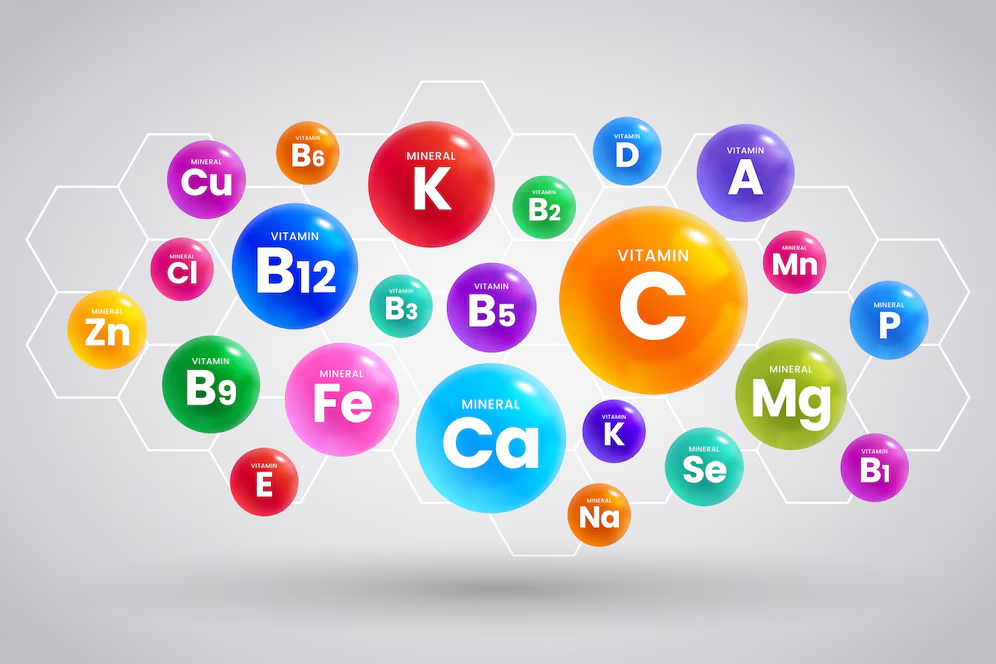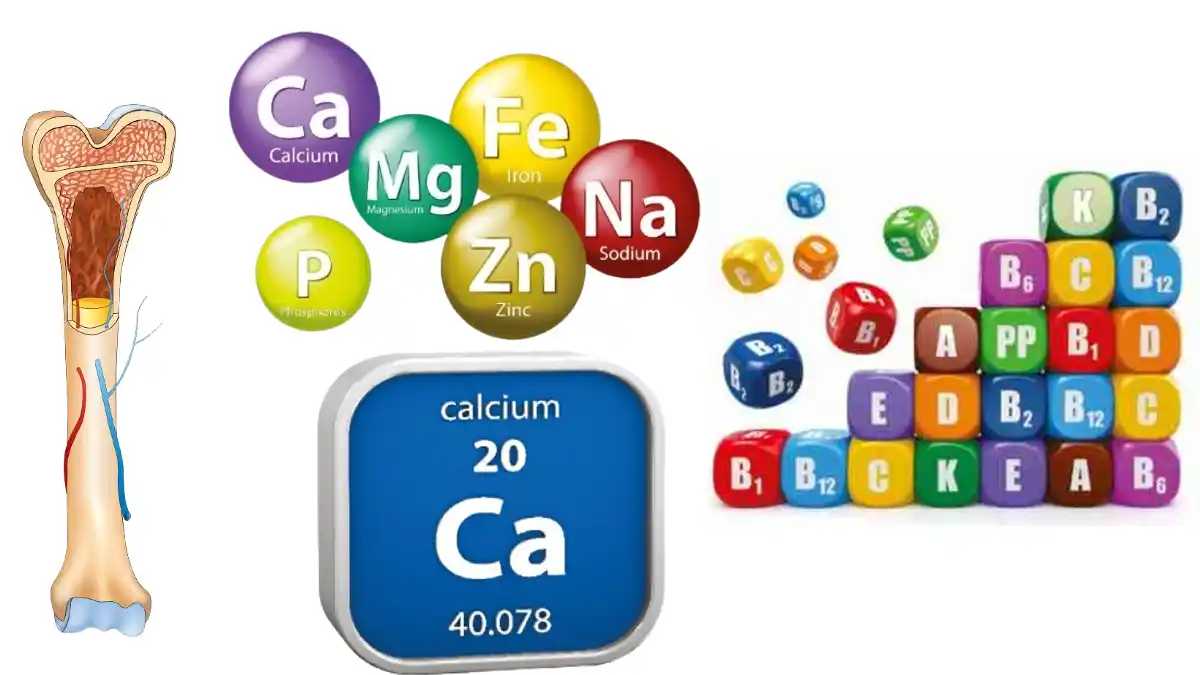Minerals & Macro-Minerals Calcium
ധാതുക്കൾ

ശരീരത്തിൽ ധാരാളം ധാതുക്കളും ലോഹങ്ങളും അടങ്ങിയിട്ടുണ്ട്. ഇവയിൽ ചിലത് ശരീരത്തിൻ്റെ ഘടനാപരമായ ഘടകത്തിൻ്റെ ഭാഗമാണ്, മറ്റുള്ളവ ശരീരത്തിൻ്റെ പല പ്രതിപ്രവർത്തനങ്ങളിലും ഉത്തേജകമായി പ്രവർത്തിക്കുകയും രാസപ്രക്രിയയെ വേഗത്തിലാക്കുകയും ചെയ്യുന്നു. ചെടികൾ മണ്ണിൽ നിന്ന് ധാതുക്കൾ സ്വന്തം കലകളിലേക്ക് സംയോജിപ്പിക്കുന്നു. ഇക്കാരണത്താൽ, എല്ലാ സസ്യാധിഷ്ഠിത ഭക്ഷണങ്ങളും ധാതുക്കളുടെ നല്ല ഉറവിടങ്ങളാണ്, കൂടാതെ മനുഷ്യർ ഉൾപ്പെടെയുള്ള മറ്റ് ജീവജാലങ്ങൾ ഈ സസ്യാധിഷ്ഠിത ഭക്ഷണങ്ങൾ കഴിക്കുന്നതിലൂടെ ഈ ധാതുക്കൾ നേടുന്നു. എന്നാൽ ഭക്ഷണത്തിൽ അടങ്ങിയിരിക്കുന്ന ചില ധാതുക്കൾ പാചകം, സംസ്കരണം, സംഭരണം എന്നിവയിലൂടെ നഷ്ടപ്പെടുന്നു.
ധാതുക്കൾ അവയുടെ സ്വാഭാവിക അജൈവ രൂപത്തിൽ ഭൂമിയിൽ കാണപ്പെടുന്നു, അതായത് അവ നിർജീവമാണ്. ഈ ധാതുക്കൾ ശരീരഭാരത്തിൻ്റെ 4% മാത്രമാണ്, അതിൽ ഭൂരിഭാഗവും അസ്ഥികളിൽ കാണപ്പെടുന്നു, പക്ഷേ ഇപ്പോഴും അവ പല ജൈവ പ്രക്രിയകൾക്കും വളരെ നിർണായകമാണ്. ധാതുക്കൾ വളരെ ചെറിയ അളവിൽ ആവശ്യമാണെങ്കിലും അവയുടെ കുറവ് ഗുരുതരമായ രോഗങ്ങൾക്കും ആരോഗ്യപരമായ പ്രത്യാഘാതങ്ങൾക്കും ഇടയാക്കും.
നല്ല ആരോഗ്യത്തിന് ധാതുക്കൾ അത്യന്താപേക്ഷിതമാണ്. എല്ലുകളുടെയും പല്ലുകളുടെയും പ്രധാന ഘടകങ്ങൾ അവയാണ്. അവ ശരീരത്തിൻ്റെ ആസിഡ്-ബേസ് ബാലൻസ് നിലനിർത്താൻ സഹായിക്കുകയും ശരീരത്തിനുള്ളിൽ അവശ്യ സംയുക്തങ്ങളുടെ ഗതാഗതത്തിൽ ഏർപ്പെടുകയും ചെയ്യുന്നു. ശരീരത്തിലെ നാഡീ പ്രേരണകൾ പകരുന്നതിനും അവ പ്രധാനമാണ്, രക്തം കട്ടപിടിക്കുന്ന പ്രക്രിയയിൽ അവ ആവശ്യമാണ്.
വിവിധ പ്രവർത്തനങ്ങൾ നിർവഹിക്കുന്നതിന് ശരീരത്തിന് ആവശ്യമായ ധാതുക്കളുടെ അളവ് അനുസരിച്ച് അവയെ തരം തിരിച്ചിരിക്കുന്നു
ഇങ്ങനെ:
മാക്രോ ധാതുക്കളും
സൂക്ഷ്മ ധാതുക്കൾ.

മുതിർന്ന മനുഷ്യരുടെ ഭക്ഷണത്തിൽ പ്രതിദിനം 100 മില്ലിഗ്രാമിൽ കൂടുതൽ മാക്രോ-മിനറലുകൾ ആവശ്യമാണ്. മഗ്നീഷ്യം, കാൽസ്യം, പൊട്ടാസ്യം, ഫോസ്ഫറസ്, സൾഫർ, ക്ലോറിൻ, സോഡിയം എന്നിവ ഇതിൽ ഉൾപ്പെടുന്നു.
സൂക്ഷ്മ ധാതുക്കളെ ട്രേസ് മിനറൽസ് എന്നും വിളിക്കുന്നു, അവ വളരെ ചെറിയ അളവിൽ, അതായത് പ്രതിദിനം 20 മില്ലിഗ്രാമിൽ താഴെ ആവശ്യമാണ്. സിങ്ക്, ക്രോമിയം, വനേഡിയം, സെലിനിയം, മാംഗനീസ്, ചെമ്പ്, അയഡിൻ, മോളിബ്ഡിനം, ബോറോൺ, സിലിക്കൺ, ഫ്ലൂറിൻ, കോബാൾട്ട് എന്നിവ ഇതിൽ ഉൾപ്പെടുന്നു.
മാക്രോ-മിനറൽസ് കാൽസ്യം

ശരീരത്തിലെ ഏറ്റവും സമൃദ്ധമായ ധാതുവാണ് കാൽസ്യം. 70 കിലോഗ്രാം ഭാരമുള്ള ഒരു മുതിർന്ന വ്യക്തിയുടെ ശരീരത്തിൽ ഏകദേശം 1.2 കിലോ കാൽസ്യം അടങ്ങിയിട്ടുണ്ട്, ഇത് ശരീരത്തിലെ മൊത്തം ധാതുക്കളുടെ 39% ഭാരവും ഉൾക്കൊള്ളുന്നു. എല്ലുകളിലും പല്ലുകളിലും 99% കാൽസ്യം അടങ്ങിയിട്ടുണ്ട്, ഇത് അവയ്ക്ക് ശക്തിയും കാഠിന്യവും നൽകുന്നു. ബാക്കിയുള്ള 1% ശരീര ദ്രാവകങ്ങളിലും ടിഷ്യൂകളിലും കാണപ്പെടുന്നു. ഭക്ഷണത്തിലൂടെ ലഭിക്കുന്ന കാൽസ്യം മുഴുവനും ശരീരത്തിൽ ലഭ്യമല്ല. സാധാരണയായി കഴിക്കുന്ന കാൽസ്യത്തിൻ്റെ 20-30% മാത്രമേ ശരീരം ആഗിരണം ചെയ്യുകയുള്ളൂ. കാൽസ്യം-ഫോസ്ഫറസ് അനുപാതം കാൽസ്യം ആഗിരണം ചെയ്യുന്നതിനെ സ്വാധീനിക്കുന്നു. കാൽസ്യത്തിൻ്റെ ആഗിരണം വർദ്ധിപ്പിക്കുകയോ കുറയ്ക്കുകയോ ചെയ്യുന്ന വിവിധ ഘടകങ്ങളുണ്ട്. വിറ്റാമിൻ ഡി, ലയിക്കുന്ന ഫൈബർ ഇൻസുലിൻ, അസിഡിക് അന്തരീക്ഷം, കുറഞ്ഞ കൊഴുപ്പ് സാന്ദ്രത, ഉയർന്ന പ്രോട്ടീൻ ഉപഭോഗം എന്നിവ കാൽസ്യം ആഗിരണം വർദ്ധിപ്പിക്കുന്നു. വിറ്റാമിൻ ഡിയുടെ അഭാവം, ഉയർന്ന കൊഴുപ്പ് ഉപഭോഗം, പഴങ്ങളിലും പച്ചക്കറികളിലും ഫൈറ്റേറ്റുകളുടെയും ഓക്സലേറ്റുകളുടെയും സാന്നിധ്യം, ഇരുമ്പ് പോലുള്ള ധാതുക്കൾ കാൽസ്യം ആഗിരണം കുറയ്ക്കുന്നു. പ്രായത്തിനനുസരിച്ച് കാൽസ്യം ആഗിരണം ചെയ്യപ്പെടുന്നതും കുറയുന്നു.
കഴിക്കുന്ന കാൽസ്യത്തിൻ്റെ 70-80% മൂത്രത്തിലൂടെയും മലത്തിലൂടെയും ശരീരത്തിൽ നിന്ന് നീക്കം ചെയ്യപ്പെടുന്നു. വിയർപ്പിലൂടെ 15 മില്ലിഗ്രാം കാൽസ്യവും നഷ്ടപ്പെടുന്നു.
പ്രവർത്തനങ്ങൾ
എല്ലുകളുടെയും പല്ലുകളുടെയും രൂപീകരണത്തിനും പരിപാലനത്തിനും ഒരു ഘടനാപരമായ ഘടകമെന്ന നിലയിൽ കാൽസ്യം ആവശ്യമാണ്. എല്ലുകൾക്കും പല്ലുകൾക്കും ബലം നൽകുകയും അവയെ ബലമായി നിലനിർത്താൻ സഹായിക്കുകയും ചെയ്യുന്നു. അസ്ഥികളുടെ ധാതുവൽക്കരണം വർദ്ധിപ്പിച്ച് ആർത്തവവിരാമം കഴിഞ്ഞ സ്ത്രീകളിൽ ഓസ്റ്റിയോപൊറോസിസ് തടയുന്നു. ഹൃദയത്തിൻ്റെ സാധാരണ പ്രവർത്തനത്തിനും പേശികളുടെ സങ്കോചത്തിനും ഇത് ആവശ്യമാണ്.

കുറവ് ലക്ഷണങ്ങൾ
കാൽസ്യത്തിൻ്റെ കുറവ് കുട്ടികളിൽ റിക്കറ്റുകളിലേക്ക് നയിച്ചേക്കാം, അതിൽ എല്ലുകൾ മൃദുവാകുകയും കാലുകൾ വില്ലുപോലെ വളയുകയും ചെയ്യും. മുതിർന്നവരിൽ ഇത് ഓസ്റ്റിയോമലാസിയയിലേക്കും പ്രായമായ സ്ത്രീകളിൽ ആർത്തവവിരാമത്തിന് ശേഷം കാൽസ്യത്തിൻ്റെ ആഗിരണം കുറയുകയും അസ്ഥി ധാതുക്കളുടെ സാന്ദ്രത (ബിഎംഡി) പരിശോധനയിലൂടെ തിരിച്ചറിയാൻ കഴിയുന്ന ഓസ്റ്റിയോപൊറോസിസിലേക്ക് നയിക്കുകയും ചെയ്യുന്നു. ഈ പരിശോധനയുടെ സാധാരണ മൂല്യം -1 ആണ്, പരിശോധന ഫലം -2.5 അല്ലെങ്കിൽ അതിൽ കുറവാണെങ്കിൽ, അത് ഓസ്റ്റിയോപൊറോസിസിനെ സൂചിപ്പിക്കുന്നു. ഓസ്റ്റിയോപൊറോസിസിൽ, ശരീരം അസ്ഥികളിൽ നിന്ന് കാൽസ്യം വലിച്ചെടുക്കുന്നതിനാൽ അസ്ഥികൾ നിർജ്ജീവമാകുന്നു. രക്തത്തിൽ കാൽസ്യത്തിൻ്റെ അളവ് കുറവാണെങ്കിൽ, ഇത് ഒടിവുകൾക്കുള്ള സാധ്യത വർദ്ധിപ്പിക്കുന്നു. കാൽസ്യത്തിൻ്റെ അഭാവത്തിൻ്റെ മറ്റ് ലക്ഷണങ്ങൾ ഒടിവുണ്ടാകാൻ സാധ്യതയുള്ള ദുർബലമായ അസ്ഥികൾ, പല്ലുകൾ നശിക്കുക എന്നിവയാണ്. അസ്ഥികളുടെയും സന്ധികളുടെയും മോശം ആരോഗ്യം.
ഉറവിടങ്ങൾ
പാൽ, ചീസ്, ബദാം, അമരന്ത് ഇല, ചീര, കോളിഫ്ളവർ, കാരറ്റ്, കൊളക്കാസിയ ഇല, മുരിങ്ങയില, ഉലുവ, മുള്ളങ്കി, കടുക്, റാഗി മാവ്.
ആവശ്യം
സ്ത്രീകൾക്കും പുരുഷന്മാർക്കും 1000 മില്ലിഗ്രാം / ദിവസം, 65 വയസ്സിനു ശേഷം 1300 മില്ലിഗ്രാം / ദിവസം (WHO ശുപാർശ). ഗർഭാവസ്ഥയിലും മുലയൂട്ടുന്ന സമയത്തും ഓസ്റ്റിയോപൊറോസിസിലും കാൽസ്യം സപ്ലിമെൻ്റേഷൻ ആവശ്യമാണ്.
MINERALS

A large number of minerals and trace metals are present in the body. Some of these form part of the structural component of the body and some others act as a catalyst in many body reactions and speed up the chemical process. Plants incorporate minerals from the soil into their own tissues. For this reason, all plant based foods are good sources of minerals and other living organisms including humans obtain these minerals by eating these plant based foods. But some amount of minerals present in foods is lost through cooking, processing and storage.
Minerals occur in the earth in their natural inorganic form i.e. they are lifeless. These minerals make up only 4% of the body’s weight, most of it is found in bones, but still they are very crucial for many biological processes. Though minerals are required in very small quantities but their deficiency may result in serious diseases and health effects.
Minerals are vital for good health. They are the main constituents of bone and teeth. They help in maintaining acid-base balance of the body and are involved in the transport of essential compounds within the body. They are also important for transmission of nerve impulses in the body and are needed in the blood clotting process.
Depending upon the amounts of minerals needed by the body to perform various functions, they are classified
as:
Macro-minerals and
Micro-minerals.

Macro-minerals are required in the adult human diet in amounts of over 100 mg per day. These include magnesium, calcium, potassium, phosphorus, sulphur, chlorine and sodium
Micro-minerals are also called trace minerals and are required in very small amounts i.e. less than 20 mg per day. These include zinc, chromium, vanadium, selenium, manganese, copper, iodine, molybdenum, boron, silicon, fluorine and cobalt.
Macro-minerals Calcium

Calcium is the most abundant mineral in the body. The body of an adult weighing 70 kg contains approximately 1.2 kg of calcium which comprises 39% weight of the total minerals present in the body. About 99% of calcium is present in the bones and teeth which gives them strength and rigidity. The remaining 1% is found in body fluids and tissues. Not all the calcium which is ingested through foods is available in the body. Usually only 20-30% of ingested calcium is absorbed by the body. The calcium-phosphorus ratio influences the absorption of calcium. There are various factors which increase or decrease the absorption of calcium. Vitamin D, soluble fibre inulin, acidic environment, low fat concentration and high protein intake increase calcium absorption. Lack of vitamin D, high fat intake, presence of phytates and oxalates in fruits and vegetables and mineral like iron decrease calcium absorption. Calcium absorption also decreases with age.
Around 70-80% of ingested calcium is removed from the body through urine and faeces. 15 mg of calcium is also lost through sweat.
Functions
Calcium as a structural component is required for the formation and maintenance of bones and teeth. It provides strength to the bones and teeth and helps to keep them strong. It prevents osteoporosis among post menopausal women by increasing mineralisation of bones. It is also needed for the normal functioning of heart and contraction of muscles.

Deficiency symptoms
Calcium deficiency may lead to rickets in children in which bones become soft and the legs bend like a bow. In adults it leads to osteomalacia and in older women after menopause, absorption of calcium decreases and leads to osteoporosis which can be identified by bone mineral density (BMD) test. The normal value of this test is -1 and if the test result is -2.5 or less, it indicates osteoporosis. In osteoporosis, the bones get demineralised as the body draws calcium from bones. If the calcium level is low in blood, it increases the risk of fractures. Other symptoms of calcium deficiency include weak bones prone to fracture, tooth decay. poor bone and joint health.
Sources
Milk, cheese, almonds, amaranth leaves, spinach, cauliflower, carrots, colocasia leaves, drumsticks, fenugreek, raddish, mustard seeds, ragi flour.
Requirement
1000 mg/day for both men and women, 1300 mg/day after 65 years of age (WHO recommendation). During pregnancy, lactation and in case of osteoporosis, calcium supplementation is needed

